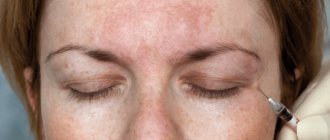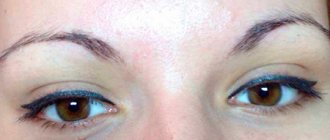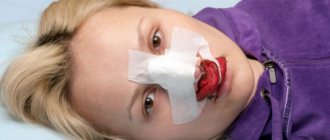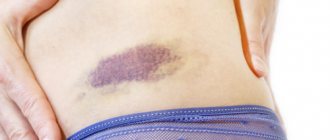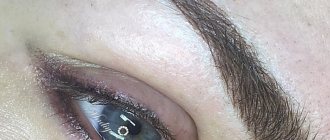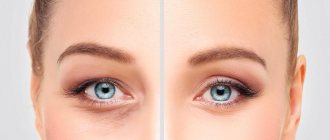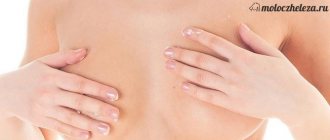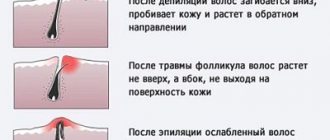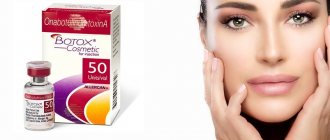May no correction be needed?
While wearing the tattoo for the first month, the woman independently decides whether she needs correction or not. If the contour and color are as desired, a repeat procedure will not be necessary.
After completing the tattoo, the artist gives recommendations on lip care and talks about the impact of negative factors that affect the final quality of the result:
- Poor nutrition. Clients notice the negative effect of eating too spicy or salty food on fresh tattoos and after correction: lips take longer to heal, the paint takes on a different shade. During the healing stage, it is recommended to give up junk food.
- Use of decorative cosmetics. Decorative pigment enters open wounds, is absorbed into the damaged area and can change color. It is recommended to refrain from using cosmetics in the area where you were recently exposed to the machine for a month.
- Visiting a solarium, spending a long time in the sun. Ultraviolet rays affect the development of permanent makeup shade.
- Too oily skin. Under the influence of a substance produced by the sebaceous glands, the lip contour may become blurred after correction. To combat such consequences of tattooing, the cosmetologist prescribes regular treatment with cleansing and disinfecting agents.
- Preparing for the procedure requires reducing the consumption of spicy foods, avoiding fatty creams and decorative cosmetics.
By following all the conditions and instructions of the cosmetologist, there is every chance of avoiding repeated correction. It is important to monitor any changes in the tattoo during recovery.
Healing process
It will not be possible to achieve bright, even and symmetrical eyebrows immediately after the procedure; be prepared for this, that for some time the area around the eyebrows will be swollen and reddened, and the eyebrows themselves will be covered with a crust, may peel, and will need to be looked after. Pay close attention to the healing process, provide your eyebrows with careful care by performing a few simple steps correctly.
- Immediately after completion of the procedure, a special applicator is applied to the eyebrows, which has a healing and soothing effect.
- To avoid infection in the punctures, for disinfection and antibacterial treatment, it is necessary to carefully
wash the eyebrows with chlorhexidine three times a day. - After treatment with chlorhexidine, use special healing ointments that are applied to the eyebrows for 10-15 minutes, then carefully removed with a napkin.
- If you are concerned about swelling of the eyebrows and superciliary area, take any antihistamine.
- During the healing period, care and moisturizing of the eyebrows is very important; you should wash your face carefully, lightly rinsing this area, preferably with warm boiled water.
- You can remove excess moisture from your eyebrows by gently blotting them with a dry, clean cloth or a damp, but alcohol-free one.
Reasons for appearance
Swelling of the lips after permanent makeup appears due to microtraumas to the skin that are caused during the procedure. To ensure that the pigment is visible for a long time, it is injected into the upper layer of the epidermis. The body considers the dye to be a foreign object, so a natural immune response occurs to it.
The production of inflammatory mediators begins, causing swelling in response to pigment entering the skin during lip tattooing. But everything quickly returns to normal with proper disinfection and care after the procedure.
If bacteria gets into the wounds, pain and redness are added to the swelling. This is a reason to see a doctor.
Cosmetological consequences
Medical problems can be eliminated with medications recommended by the doctor. Cosmetic consequences caused by errors in the work of a tattoo artist are more difficult to eliminate.
One of these complications is unsuccessful lip drawing. On the eve of the procedure, you should discuss all the details with the specialist. Only after this proceed to the manipulation.
Among the undesirable consequences of tattooing is an unsuccessfully chosen shade of the dye. To avoid problems, experts recommend choosing the tone closest to your natural lip color.
Sometimes clients complain about a blurry, spreading contour line. It is not possible to eliminate the deficiency.
Dryness and flaking of lips is caused by poor quality pigment or improper care after the procedure. The skin does not receive enough moisture, which causes discomfort. Tattooing with such a complication will not last long.
How long does swelling last after lip tattooing?
Swelling is a normal reaction of the body to a violation of the integrity of its tissues, so there is no need to worry about swollen lips after tattooing. Normally, swelling goes away 2-3 days after cosmetic manipulation, and the natural shape of the lips returns. The rehabilitation period can last up to 5 days if a woman has sensitive and dry skin that reacts sharply to traumatic influences.
An experienced tattoo artist, by looking at the client’s lips, can tell in advance how long the swelling will last.
If a week has passed and the swelling has not gone away, you should immediately consult a doctor or an employee of the cosmetology center where the procedure was performed. Swelling that lasts longer than 7 days is a clear sign of a pathological reaction. Perhaps an inflammatory reaction has begun in the skin layers due to exposure to an allergen or infection.
Prevention of swelling after permanent lip makeup
Pathological swelling after lip tattooing is easy to prevent if you follow the rules for caring for tattooed skin.
If you are prone to drug allergies, then before introducing pigment into the skin, you should ask the artist what coloring and anesthetic preparations he uses.
During the rehabilitation period, tattoo artists advise clients to adhere to the following rules:
- refrain from swimming in the pool, salt and fresh water bodies, and from visiting the sauna or bathhouse;
- do not sunbathe on the beach or in the solarium;
- do not use peeling or other care cosmetics that deeply affect the skin layers;
- do not bite your lips, kiss with caution;
- do not scratch the skin of your lips, do not wet them with water;
- before and after brushing your teeth, treat your lips with baby or restorative cream to protect the skin from the aggressive effects of water and toothpaste.;
- do not touch your lips with dirty fingers to avoid infection;
- give up cigarettes and alcoholic beverages for a one-week rehabilitation period;
- do not include hot, salty, or seasoned foods in your diet until the swelling subsides;
- Do not use decorative cosmetics until the skin has healed.
Types of complications
Despite the fact that all types of peeling procedures differ in the depth of effect and mechanism of action, their goal is the same - the removal of superficial skin layers, and therefore the main possible complications after their implementation are similar.
Predictable or possible natural complications
Erythema, which is persistent severe redness of the treated area. The severity and duration of its persistence depend on the aggressiveness of the technique. This complication often occurs in people with enlarged vascular networks on the face after deep peeling.
Swelling of the face and eyelids, which occurs due to increased permeability of small vessels and the release of the liquid part of the blood into the tissue. It may appear 1-3 days after exposure and persist for several days. More often it occurs after chemical cleansing using retinoids or trichloroacetate, laser and mechanical peeling.
Peeling is the basis of the peeling mechanism as such. It is a common consequence and goes away within 1-3 days. However, after using trichloroacetic acid or resorcinol, large scaly peeling may occur and persist for a week or longer. In these cases, it is necessary to use moisturizing creams.
Uniform darkening of the skin, which goes away on its own after exfoliation (after 1-2 weeks).
Hypersensitivity of the skin - expressed in an excessive reaction to temperature, pain, mechanical influences or to sunlight. This complication goes away in 1-2 weeks, but can persist for up to 1 year.
Hyperpigmentation occurs when there is an inadequate cellular response and excessive melanin production by cells, resulting in dark areas. This most often occurs after treatment with trichloroacetic acid or exposure to a laser beam.
Read about how to treat hyperpigmentation here.
Why does swelling occur?
The appearance of edema is caused by microdamage to the epidermis. Short-term swelling, which disappears after two to three days, is a normal reaction of the body to the intervention. If purulent discharge, severe pain and redness are added, these are alarming symptoms that may indicate:
- that low-quality consumables were used;
- about insufficient qualification of the master;
- about the infectious process;
- about the development of an allergic reaction to the injected pigment or anesthesia;
- about the presence of increased dryness of the epidermis;
- the reason why unpleasant symptoms may appear lies in improper care after the procedure.
If the tattoo is performed with high quality, in compliance with all technologies, the swelling is usually moderate and there is no significant discomfort. Symptoms of a normal skin reaction are: peeling, the appearance of thin crusts, itching. If severe redness develops, hyperthermia appears, or the lips are very swollen, it is recommended to consult a doctor to carry out treatment, eliminate the inflammatory process and cope with the infection.
Prevention of complications
After properly performed permanent makeup, swelling goes away in 3-7 days. The most severe swelling lasts for the first day. When performing the procedure on the eyebrows, the swelling is slightly less than when tattooing the lips. This is due to the different thickness of the skin in these areas.
How long lip swelling lasts after tattooing depends on the correctness of the procedure itself and skin care after it. The treated area must be disinfected before introducing pigment. To do this, use high-percentage alcohol, chlorhexidine or modern spray products. The master has disposable gloves on his hands, which are also disinfected in front of the client before and during the session.
After finishing work with the skin, the lips are again treated with a disinfectant.
Then a wound healing cream is applied to them. It contains D-panthenol (Dexpanthenol, Bepanten), which accelerates cell regeneration. It should be applied to the injured area of skin 3 days after tattooing.
How long does it take for it to go away?
After a violation of the integrity of the skin, swelling is a natural reaction of the body. Don’t be alarmed if after tattooing your mouth begins to look voluminous. After 1-3 puffiness will subside, lips will take on a natural appearance. The rehabilitation period extends to 5 days. If the client has sensitive or dry skin that reacts aggressively to cosmetic interventions. The artist can determine how long the swelling lasts after lip tattooing.
If after a week the swelling does not subside, contact the specialist who performed the procedure. This is an alarming signal of an inflammatory response.
Features of allergies to tattooing of eyebrows and lips
When planning to do permanent makeup, you need to think about whether there is an allergy to lip or eyebrow tattooing. This question is doubly logical if a woman has a predisposition to exhibit non-standard reactions to any substances or products.
Lips and eyebrows are very sensitive, and disruption of the epidermis, which is painful in itself, can provoke both old allergic reactions and new ones. Low-quality dyes, painkillers and hygiene antiseptics can all contain dangerous ingredients.
But even natural paints that contain a product to which there is an individual reaction also serve as a source of threat.
An unpleasant feature of allergies to tattooing of eyebrows and lips is that the external manifestation can be delayed in time. Medical statistics record cases where symptoms appear after 4-12 months, as well as when pigment is re-applied to already painted areas.
In order to eliminate the undesirable consequences of the procedure to create your appearance, it is advisable to adhere to simple rules:
- It is necessary to clarify in advance the compositions of dyes and additional preparations used.
- Conduct a trial external application of the dye to the skin and observe the reaction for 4-7 days. Any area of the skin is suitable for testing, but it is advisable to choose the most sensitive one, then the allergy, if this substance is an allergen, will definitely manifest itself.
- Inform the specialist before the procedure if there is confirmed information about intolerance to any drugs.
These simple steps will help minimize the possibility of an allergy to tattooing.
How to lighten eyebrow tattoo at home
How to lighten eyebrow tattoo
Sometimes the color obtained after a permanent makeup procedure ceases to be liked over time. You can correct the situation at home using the following means:
- Hydrogen peroxide. The pigment brightens several tones.
- Lightening with iodine. Apply carefully using a cotton swab.
- Castor oil treatment.
Additionally, the skin needs to be scrubbed, peeled, and lightening creams applied. But experts recommend not experimenting at home, but seeking help from professionals.
What to do in the first days after the procedure
After coming home from cosmetology, you may think that the shade of your eyelid tattoo is too bright. This side effect subsides after a recovery period, and is due to the fact that the dye has not yet been absorbed locally.
The normal reaction of the skin to the introduction of a foreign substance into it is redness and swelling. It appears in most women. To get rid of the problem, make ice compresses. However, there is no need to wet the skin, so put the ice in a bag, wrapping it in a thin towel. Signs subside within two days.
You need to immediately start smearing the eyelid tattoo area with an antiseptic and healing ointment, which the cosmetologist advised you to do, this will speed up the healing of the tissue. This should be done every hour or hour and a half.
You cannot paint your eyelashes at this time, because while you paint the eyelash area, some of the decorative cosmetics fall on the tattooed area, and this disrupts the healing process. Also, dyeing eyelashes is harmful to their condition. If you dye your eyelashes at normal times, their brightness will deteriorate, so taking a break will benefit the health of your eyelashes.
When a crust appears on the eyelids, you need to smear them less often - 5 or 6 times a day. The protective layer creates a barrier for the eyelid, making it more difficult to damage. However, there is no need to rip it off, since there is an open wound underneath.
If the crust is damaged, it is necessary to lubricate the area with a generous layer of antiseptic, and then with a healing ointment. This will help prevent infection from entering the damaged area.
Spontaneous peeling of the crust usually occurs on the sixth and seventh days after tattooing, and is accompanied by severe itching, which is difficult to tolerate.
As a last resort, you can wet a cotton pad and apply it to the crust, pressing slightly on top. This will reduce the itching a little, and the protective layer will remain intact.
This is where the first days of care end; at this time, it is important to provide proper care every day. In the remaining time of rehabilitation of the epidermis, one should only create external conditions for the regeneration of the integument.
Common mistakes in choosing aids
When choosing a product that will care for the skin during the recovery period, you must remember that only panthenol-based medications are allowed.
Eyebrows should be smeared with panthenol-based cream
It should also be free of any brightening component . It is better to choose such a product in the same salon where the tattoo procedure itself takes place.
Castor, sea buckthorn and similar oils are prohibited from being used in this case.
They will pull pigment out of the skin, resulting in the end result not being as desired. Eyebrows will lose color significantly.
Hormone-based drugs , as well as hydrogen peroxide, are prohibited. It’s better not to smear anything on weakened eyebrows after a tattoo session than with these products. They will only worsen the situation and develop the inflammatory process.
Recommendations for facial care after laser resurfacing
During the regeneration period, the skin becomes more sensitive and unprotected, and therefore needs careful care. Cold and open sunlight are not the best helpers for restoring skin immunity. In view of this, for rehabilitation after laser resurfacing, you need to make friends with sunscreen (SPF at least 40!) for at least six months. During the cold season, special protective creams should be used.
To restore skin after laser resurfacing, sauna or steam room lovers will have to change their habits for 4 months, since exposure to high temperatures can nullify all the achievements of the procedure. Hot baths are also not advisable. Considering the stress the body experiences, you should not become physically overtired.
How does the procedure itself work?
First, the eyelids are cleaned of sebum and cosmetics. An anesthetic is applied in the form of a cream and the eyelids are covered with a film for better absorption. Then remove it with a napkin, not water. Then the master performs the procedure itself, applying the dye under the skin into its middle layer with a machine or hand-held device.
The eyelid is stretched to fill all the folds. Although the punctures are at a shallow depth. Blood appears due to damaged capillaries. It takes some time for wounds to heal. Once completed, the eyelids are wiped with an anesthetic. At the end, a healing cream is applied.
Correction for small corrections is often required after a month and is carried out free of charge. You can see “before” and “after” photos of eye tattoos in the article.
Stages of recovery after tattooing
Keep in mind! The entire process of restoration of eyelid tissue after tattooing is divided into several stages.
And although the timing of each of them may deviate from the average for different people, in general it looks like this:
- Stage of inflammation. When the skin and blood vessels are damaged, inflammation occurs as a protective reaction, characterized by pain, redness of the skin and the development of swelling.
- Reproduction stage. This is the third day after the procedure, the inflammation has already subsided and cells begin to divide to replace the damaged areas. And after another day, the lining of the newly formed cellular material occurs.
- Epithelization. On the same fourth day, the processes of formation of new layers of tissue begin to take place even more strongly. At the same time, lymph, blood cells and pigment particles emerging from microtrauma caused by a needle form a protective crust. At first it looks like ichor, but the oxidizing blood soon dries out and forms a hard crust.
- After about a week, new skin tissues completely replace the dead old ones, and the crust separates from the eyelid. At the same time, inflammation finally disappears. The color during this period may seem incorrect, but this can already be corrected by correction, which must be carried out during tattooing.
You should know! Healing takes place after a month. The pigment is completely distributed and will no longer change color.
The healing process ends here and further correction must be carried out.
What to do if your tattoo goes wrong
Sometimes the color of eyebrows changes after tattooing. Why? If a low-quality pigment is used or the artist is not competent enough, the eyebrows acquire a completely different color from what we would like.
Types of eyebrow tattoo
Blue eyebrows should absolutely not be covered with black pigment, otherwise they will become even bluer. Unsuccessful tattooing must be corrected gradually, over two or three procedures. Special color correctors are used.
On a note! You can also remove the pigment with a laser. This is quite long and expensive. At least 5 procedures will be required.
To cover red, the Itten color wheel is used. The pigment that needs to be overlapped is located opposite the one that needs to be taken for overlap. You need to take an olive corrector.
Pink eyebrows can also be covered with an olive corrector pigment. As a result, the eyebrows will become light brown.
Note! To change the gray color to brown, red camouflage pigments are used.
Wide eyebrows can be corrected with light shadows, lightened with a flesh-colored pencil, or resort to laser.
What is forbidden to do after eyelid tattooing?
Stay up to date! After tattooing the eyelids until they heal, it is prohibited:
- use decorative cosmetics;
- peel off the crusts that form;
- exercise and avoid physical stress;
- wash and take a bath (washing can be replaced by wiping your face with wet wipes;
- sunbathe and visit saunas, baths and beaches;
- wet your eyelids.
When can you have a full bath?
Full washing is acceptable after complete healing.
It is characterized by the complete removal of crusts, the disappearance of itching and peeling, and the cessation of discoloration of the tattoo.
Usually this takes a month, but for some people this period begins within three weeks, while others have to wait a month and a half.
Prevention of the problem
To prevent a number of negative consequences, it is recommended to adhere to the following preventive measures:
- do not wet the skin during the first 24 hours after the procedure;
- do not touch your lips with your hands, perform all treatments only under sterile conditions;
- do not eat too spicy, hot or salty foods;
- minimize smoking or give it up altogether;
- do not drink alcohol during the entire recovery period;
- if you are prone to allergic reactions, it is better to consult a specialist before applying permanent makeup;
- do not use decorative cosmetics.
With the help of permanent makeup, you can solve a number of cosmetic or medical problems, disguise scars and asymmetry. Before performing the procedure, it is necessary to take measures to prevent complications - choose a qualified specialist, buy all the necessary products for lip care after the session, ensure peace and comfort for the entire rehabilitation period. Check with your cosmetologist about what methods to deal with unpleasant manifestations, what is a normal reaction, and what signs are alarming. If all conditions are met, the recovery period will pass quickly and without consequences.
Chief author and editor-in-chief: Makarskaya S.E., 29 years of experience.
Having decided to change their appearance with the help of permanent makeup, patients must be mentally prepared not only to receive positive results, but also to a long period of rehabilitation. Unfortunately, quite often recovery can be accompanied by side effects and complications, the most common of which is considered to be swelling. It causes the most inconvenience, changing facial features beyond recognition and may even be accompanied by painful sensations.
Why allergies occur
During the tattooing process, a coloring pigment is introduced under the skin to a depth of 2–3 mm and remains in the surface layers for 2–3 years. In the production of cosmetics, natural ingredients are used that do not lead to consequences in the form of allergic reactions. Some girls with hypersensitivity may experience unpleasant symptoms in response to an irritant detected by the body.
Tattoo ink is universal; there can be an individual reaction to the substance.
Do you need advice from a beauty expert? Get advice from a beauty expert online. Ask your question right now.
ask a free question
Allergy, as a consequence, manifests itself:
- redness of the skin;
- the appearance of a rash.
Allergies to tattooing can occur to various disinfectants and degreasers used by the artist. After adding the coloring pigment, the specialist applies a healing ointment to the skin. Swelling and redness may occur as a consequence of a reaction to certain components in the composition.
Possible complications
Permanent makeup can last a long time and retain its original color for up to 2-3 years, but the introduced pigment is a foreign substance for the human body and it is normal that it reacts with a variety of reactions. When performing unnatural actions, you need to understand that the skin will swell and hurt, because it fights the introduced agent. But dye removal is rarely required. The consequences are reversible and end with successful healing.
A common nuisance is herpetic rashes. Rarely is this a consequence of infection in the cabin; more often the virus is in the human body. Under favorable circumstances, it activates and manifests itself. The main symptoms of the disease are swelling and painful ulcers that make it difficult for the tattoo to heal.
Infection is a dangerous consequence. It occurs as a result of the technician working with undisinfected instruments or when the rules for caring for damaged lips are violated. In the first days, it is difficult to determine swelling of an infectious nature from a normal one. If in the subsequent period there is redness and severe pain, then it’s time to see a doctor. Self-treatment is prohibited; the development of an adequate therapeutic regimen is required.
To avoid negative consequences it is necessary:
- Avoid contact with water on the first day.
- Do not touch lips with dirty hands, carry out processing under sterile conditions.
- Do not eat spicy, hot, salty foods.
- Stop smoking and drinking alcohol for the entire period of rehabilitation.
- If you have allergic reactions to medications, check with the specialist what drugs are used for anesthesia (injection, application).
- Do not apply cosmetics to damaged skin until it has healed.
A tattoo on the lips looks beautiful and solves a number of cosmetic and medical problems: masking scars and asymmetries. Before coloring, take measures to prevent complications: choose a qualified specialist, purchase care products, ensure peace and comfort during the recovery period. Ask your cosmetologist how to relieve swelling and other consequences after lip tattooing, and what symptoms should cause concern. If the conditions are met, rehabilitation will proceed unnoticed.
Source: ProGuby.ru
Features of care in winter and summer
At different times of the year, eyelid skin care has its own characteristics.
Important! In summer, you need to wear sunglasses, as the tattoo will fade from exposure to ultraviolet radiation, regardless of how much time has passed since the procedure.
To maintain healthy skin, you can take vitamins D, E and A or multivitamin complexes containing them.
Fatty creams and ointments are not used, and swimming in open water is strictly prohibited for a month.
In winter, first of all, you need to take care of your immunity, since any colds will also provoke inflammation in the eyelids.
For this you also need to take vitamin complexes.
If possible, in cold weather it is better to try not to go out for at least two weeks, since there is nothing to protect your eyelids from wind, snow and cold.
How to properly, effectively and safely care for your eyebrows
Eyebrow care after permanent makeup
In the first days, you should not act aggressively on the skin. For healing to be quick and successful, it is important to follow certain rules of care. Immediately after the procedure, redness, swelling and inflammation are observed, which disappear on their own within two to three days. This is a normal reaction of the epidermis to punctures.
Note! The duration of the entire recovery period takes on average from a week to two.
When the tattooing procedure is completed, the artist applies a thick layer of protective ointment. During the first two hours, the skin rests. After which you need to rinse carefully with micellar water, apply “Bepanten” or “Panthenol” (or another product as recommended by the specialist). During the first day, you should not drink alcohol to prevent the punctures from bleeding.
Note! Treatment during the first three days is carried out using “Chlorhexidine” or “Miramistin” (apply to a clean cotton pad and gently blot the skin). Next, when the epidermis is dry, apply Bepanten.
Starting from the fifth day, you need to smear the skin with healing agents 3 times a day. Duration of care - 10 days. After a few days the crusts should come off.
It is forbidden:
- tweeze eyebrows;
- go to the bathhouse, sauna;
- visit the swimming pool and solarium;
- use cosmetics for 7 days.
Facial cleansing is allowed no earlier than 3 weeks after tattooing. This time is enough for complete healing of micropunctures.
In the first days, you should not act aggressively on the skin.
Care from the first to the tenth day
At different stages, healing can be stimulated and facilitated by using various drugs.
From the very first day, immediately after the procedure, a course of using healing drugs (depanthenol, bepanten) begins.
And in parallel with them, the antiseptics miramistin or chlorhexidine are used to prevent the development of infection.
These solutions can be applied to the eyelids 5-7 times a day or more often if regeneration occurs with complications. On the second day, the use of the same drugs continues.
Note! You can also start dabbing the protruding ichor with a cotton pad soaked in antiseptic.
On the third and fourth days, you can use the preparations less frequently, and there is no longer any need to blot the ichor: it stops oozing and forms a quickly drying crust.
On the fifth day, it is enough to use healing ointments no more than four times a day.
The crust will begin to itch and itch, but you cannot touch it: the itching indicates the completion of the regenerative processes, and in a couple of days it will go away.
There is no longer any need to lubricate the tattoo with antiseptics, but healing creams must be used three times a day until the tenth day.
Healing ointments
Healing ointments will be needed after getting a tattoo in any case, no matter what drugs are used to relieve pain. Experienced tattooists advise using such products on the second or third day after the session. They should not be applied directly to injured skin, as this can cause pigment release.
During the healing process, itching occurs as the skin dries out and tightens. This can lead to cracks, which will be accompanied by painful sensations. In addition, the design may become deformed. To prevent this from happening, it is recommended to choose ointments that contain vitamins A and D. For example, Bepanten plus or D-Panthenol. They promote rapid healing and do not affect the quality of the tattoo.
How to remove swelling
After applying permanent makeup, the master should talk about skin care and explain how to remove swelling after tattooing the lips or other area. The swelling is removed with ointments with an antihistamine effect. These include Fenistil and Elokom. They are applied topically to the disturbing areas 2-3 times a day for 3 days.
When swelling subsides after lip tattooing, the use of antihistamines is no longer required. But it is worth continuing to use wound-healing drugs. These include Dexpanthenol, Bepanten or ointments based on natural ingredients (Badyaga, Spasatel). They help relieve discomfort that occurs against the background of tissue regeneration.
Causes and symptoms of edema
Before the procedure, the woman is warned when the swelling after lip tattoo will subside and her face will look neat and natural again. The dye is injected to a depth of 1-2 mm with a thin needle, damaging the skin. After injury, healing and restoration of wounds occurs. Short-term swelling is considered normal, but the addition of purulent discharge, pain, and redness are cause for concern.
The causes of painful swelling are:
- use of low-quality consumables;
- insufficient qualification of the master;
- infectious infection;
- allergic reaction to the injected dye or anesthetic drug;
- increased skin dryness;
- violation of the rules of care and hygiene in the post-procedure period.
If the procedure is performed efficiently, in compliance with the technology, the swelling is moderate and does not cause discomfort. Symptoms of normal swelling:
- peeling;
- formation of thin crusts;
- moderate itching.
Skin care after the procedure
After lip tattooing, swelling can last from 3 to 7 days. It will subside faster if you take proper care of your skin. There are several rules:
- Do not be in the open sun for the first 14 days after the procedure.
- Do not visit places of mass bathing until complete healing.
- Do not eat too cold, hot or spicy foods while your lips are sensitive.
- Protect your skin with creams with a UV filter when going outside.
If you do everything as described in the rules, the swelling will subside quickly. Girls prone to allergic reactions can take antihistamines orally. They are available in the form of tablets and drops. The most effective include Suprastin, Zodak and Zyrtec. The dosage depends on the age of the person.
Lip tattooing allows you to reduce the time you spend on makeup in the morning and throughout the day. At the same time, you don’t have to worry about the lipstick running, washing off at the wrong time, or imprinting on the glass. But the procedure carries some inconvenience due to the swelling that appears. Special preparations will help remove it, so you should not give up permanent makeup for this reason.
How to relieve swelling
To avoid complications, listen to the recommendations and advice of the specialist on care after the procedure. A qualified specialist issues a memo containing rules and a description of medications that help relieve severe swelling.
Medications:
- Hydrocortisone ointment. Hormone-based drug. Use strictly according to instructions. Treatments should be carried out up to 3 times a day on the affected area. The composition should not come into contact with the eyes or mouth. After the procedure, wash your hands thoroughly.
- Dexamethasone drops. The product is designed to treat the eyes, but it is recommended to relieve swelling of the lips after applying permanent makeup. Drops are used as lotions and compresses. Apply twice a day for 5-10 minutes.
- To eliminate unpleasant symptoms, an antihistamine is prescribed. Tavegil, Suprastin, Diazolin, which are available in the first aid kit, are effective. Before taking, study contraindications, side effects, and calculate the dosage.
- To relieve swelling after cosmetic procedures, targeted medications are used - diuretics. The main task of these drugs is to remove fluid from the body. Famous ones are Prednisolone and Furosemide. Take carefully, they have a number of serious side effects! Important microelements are removed along with the liquid!
- Spasatel, Pantestin, and Tetracycline ointments promote rapid healing. They help relieve swelling, redness, quickly remove inflammation, and prevent infection of damaged skin. Application to the injured area up to 4-5 times a day can significantly reduce the rehabilitation period.
- Dry ice is a remedy that will return your lips to their normal appearance. With its help, make compresses for 5-7 minutes, with breaks of 2 hours. Before the procedure, the ice is wrapped in dry, dense natural fabric. The fabric must be clean, otherwise the lip will become inflamed from dirt particles.
Each pharmacy offers medications for sale. It won't be difficult to purchase them.
Causes of significant swelling
So, what could be the reason for the fact that swelling after tattooing lasts more than a few days? In fact, there are quite a few reasons for this phenomenon, including:
- Low quality pigment used for tattooing.
- Increased sensitivity of the skin, tendency to swelling after the intervention.
- Allergic reaction to pigment or pain relief.
- Infection.
All of these prerequisites (except for the very last one) lead to the formation of non-dangerous, but very unpleasant long-term swelling. Persisting for several days or weeks, it causes a lot of unpleasant sensations, forcing you to look for ways to combat such negative manifestations.
